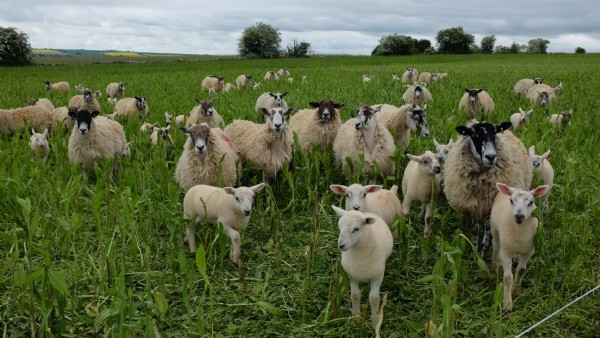

We have now planned a new crop rotation on our arable land, dividing our small arable area into an eight year rotation and demonstrating a method of diverse ley farming designed to improve sustainability, animal health, soil fertility and ultimately boost the profitability of a farm. It’s a system which can be adapted to suit many small farms.
For the first four of these years, the land will be given over to leys, so our first job this spring with the ley (a fertility building herbal ley) was to fence an eight acre area for mob (cell) grazing.
The benefits of mob grazing are that it prevents livestock repeatedly seeking a favourite spot and severely trampling the soil as well as concentrating manure to get high levels of it returned to the soil across the whole field. We also find that when grazing diverse swards, if allowed to choose, livestock will preferentially graze the most delicate, tasty species. If these species are not allowed a break to regrow, they may be grazed out of the sward, lowering the overall diversity and hampering the effects of a fertility building ley.
We’ve chosen electric fencing which is a cheaper, more effective, and very versatile way of containing livestock in any shape or size area. It is designed as a psychological barrier which sheep and cattle fear to cross, rather than a purely physical one. Portable electric fencing gear also allows for subdivision of pastures, mimicking wild migration patterns where predators keep herds bunched together and migrating as a group.
We are using a semi permanent outside fence with portable electric fencing to make strips inside for maximum flexibility. The benefit of using a portable electric fence inside a permanent electric fence grid is that the portable wires allow you to change the size of the paddocks over the course of the grazing season as the grass growth speeds up, slows down, or becomes dormant.
It’s important to make sure that plants do not touch the wire, otherwise the electricity will go to earth rather than to the animal, so we used our flail mower to mow a strip a couple of metres wide prior to staking. This is maintained every week by cutting under the fences with a pedestrian 1 metre wide Allen Scythe.
It was hugely satisfying to bring thirty ewes and sixty lambs from Nigel and Ed Adam’s farm and watch them emerge from the livestock trailer and begin grazing the lush ley and move them every day. It only took about twenty minutes a time. After the first couple of days the sheep knew what to do, and as soon as the fence was moved and they could see their way open to lush ungrazed herbal ley, they walked on through, following each other just like…sheep!
We also addressed the issue of bringing drinking water to the different areas as the sheep are moved. We installed a bowser with a 1000 litre capacity which is pumped full from the spring so all we have to do is move the small empty trough each day, and in the future when different fields are given over to pasture in the rotation, we can simply move the water pipe to the new areas.
Last year, our arable fields were planted with Summer Quick Fix green manure which we over-wintered and ploughed in the spring and have power harrowed, rolled and planted with cereals; spring wheat, spring oats and spring barley, which are now ready for harvest. After sowing the spring wheat we’ve undersown our standard mix of yellow trefoil and white clover under it as an intercrop. This will act as a soil improver, to be grazed after the wheat has been harvested.
Mob Grazing Guide:
It seems that everyone’s talking about mob-grazing (or cell grazing) these days - a term used to describe a method of grazing and frequently moving livestock systematically around a field to graze different sections in rotation. It’s cheap, as a managed diverse ley reduces the need for inputs, chemical fertilisers and feed supplements, since crops with overlapping growth patterns provide year-round forage. But is it for you and if so, how do you go about implementing it?
We’ve produced a ‘Guide to Mob-Grazing’ which covers everything from ‘What is Mob-Grazing’, to its benefits and whether or not it might be right for your farm. It then goes on to discuss how to get started, with sections giving information and advice on fencing, water supply and moving animals.&
Date Posted: 28th September 2016




